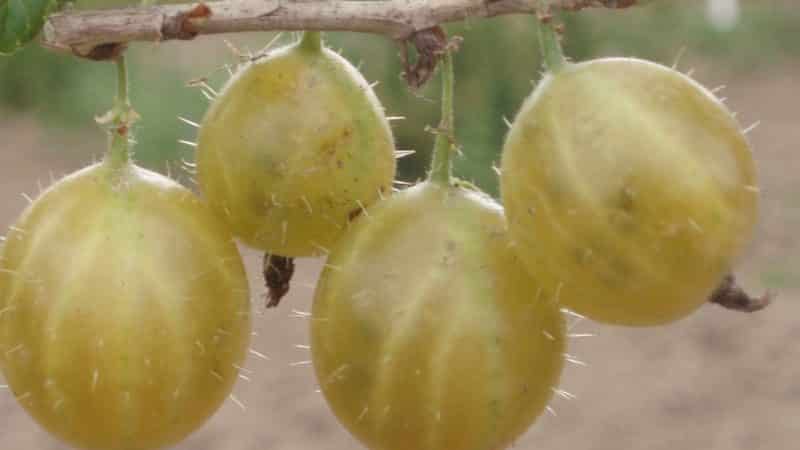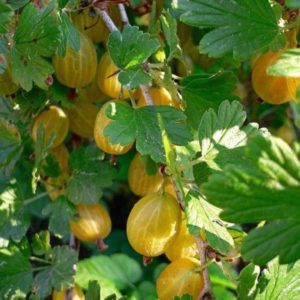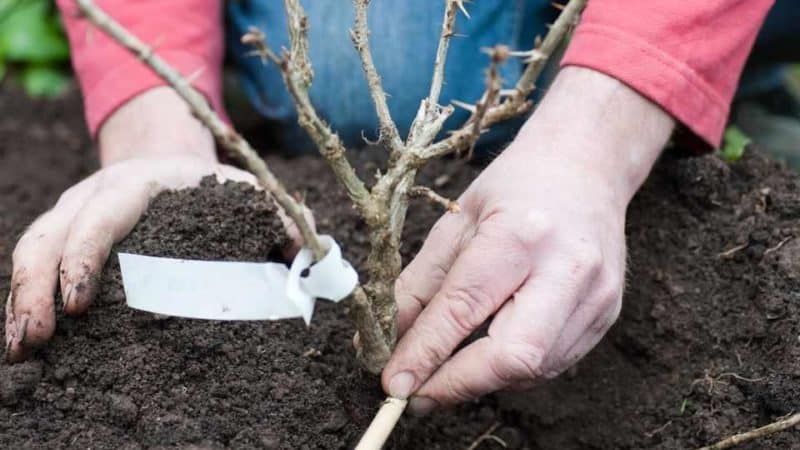General characteristics and description of hairy gooseberry varieties
Gooseberry is a berry that is familiar to many from childhood. This plant has not lost its popularity today, and the number of available varieties has increased. Despite this, more and more gardeners want to grow the hairy gooseberry, which they remember from the days of their grandmother’s garden.
Hairy gooseberries used to be grown everywhere. These varieties of fruit and berry bushes are distinguished by their sweet taste and pleasant aroma. However, they are rarely found on sale due to their low resistance to fungal diseases. What varieties have fluffy berries and how to grow them on your site - read on.
General characteristics of hairy gooseberry
Gooseberry with shaggy berries is not a separate type of fruit and berry bush. This is a characteristic feature of some gooseberry varieties. During the Soviet era, most of the grown representatives of this crop had a similar property.
Nowadays, finding a variety with similar indicators is problematic. This is due to the fact that most of them do not have high resistance to fungal diseases. They are especially often affected by powdery mildew. Because of this, more and more gardeners prefer more modern shrubs with smooth berries and high immunity.
The berries of this gooseberry are covered with hairs. Pubescence can be either dense or sparse. The peel of such fruits resembles kiwi. It is rough, so it protects the berries from cracking and deformation during transportation.
Varieties with hairy berries are distinguished by compactness of the bush, powerful and thick shoots. They are hardy and undemanding to the composition of the soil, easily tolerate winters and do not break due to strong winds.
The color and size of the berries depends on the gooseberry variety. Fruits of all hairy varieties very sweet. This is what attracts most gardeners to them.
Note! Wild gooseberries also have hairy berries.
Hairs are absent only on the fruits of shrubs of more modern varieties. Older plants produce a crop with pubescence, the severity of which may vary.
Varieties
To buy shaggy gooseberries, you need to know the name of the variety. There are many representatives of this culture with berries whose peel is covered with hairs. Reviews from gardeners indicate that three of them have the best taste.
Early Gennings

Hairy gooseberry variety Early Gennings is one of the most famous. It has many positive reviews from gardeners and is easy to find in online stores.
Characteristics of the Early Gennings variety:
- The bush is tall, medium spreading. The shoots are powerful and thick, young ones are green and old ones are brown. The bush is straight, the branches grow upward.
- The leaves are leathery, small in size, light green, with cut edges.
- The flowers are white or cream, medium in size. Often solitary, less often collected in inflorescences of two. It has elongated and narrow petals.
- The fruits are large, oval in shape. The peel is dense, with a lot of long hairs. The taste is sweet, the characteristic aroma is rich, the seeds are small. The color of ripe berries is greenish-yellow.
- In terms of ripening – early ripening.
- Winter hardiness is high. Withstands cold temperatures down to -25...-30°C without shelter.
- Immunity is average.Susceptible to powdery mildew.
English yellow

English yellow - another famous variety with hairy berries. It is distinguished by its large size and bright yellow color of ripe fruits. Its originator is unknown.
Characteristics of English Yellow:
- The bush is medium-sized, reaches a height of 1.5 m. The shoots are powerful, thick, straight. The plant is slightly spreading. Young shoots are green, becoming gray-brown with age. There are thorns.
- The leaves are small, cut, with five lobes and serrated edges. The color is dark green.
- Flowering begins in May. The flowers are yellow-green, solitary. Size is medium.
- The fruits are medium in size, the weight of each berry reaches 8-9 g. The shape is oval with a narrowing on one side. The skin is dense but thin. There is slight pubescence. The color of the shell and pulp is bright yellow. The pulp density is average. The taste is sweet with slightly sourness. The aroma is not intense. On average, 15 kg of crop is harvested from a bush per season.
- Ripening time is average.
- Winter hardiness is high, up to -30°C.
- There is resistance to most diseases characteristic of the culture, except for spheroteka.
The disadvantage of the English variety is its tendency to crack the berries.
Transparency
Transparent is one of the largest-fruited varieties. It has the following characteristics:
- The bush is medium-sized, up to 1.5 m in height. Slightly spreading. The branches are strong, straight, and do not bend under the weight of berries. The shoots are brown, without thorns.
- The leaves are small, bright green, with cut edges.
- The flowers are cream-colored, small in size, solitary.
- The fruits are very large. The weight of each berry reaches 40 g. The shape is oval. The skin is dense, white or light green. The fruits are fleshy but juicy. The taste is sweet, with slightly expressed sourness and astringency.The aroma is rich.
- Medium-late in terms of ripening.
- Winter hardiness is low. Recommended for cultivation in the southern regions. When frosts exceed -25°C without shelter, it may freeze.
- There is immunity to all fungal diseases, except powdery mildew.
Like all large-fruited varieties, Transparent is demanding when it comes to fertilizing. If the soil is not fertile enough (fertilization regime is not followed), the berries are crushed.
Features of planting and caring for hairy gooseberries
Growing fluffy gooseberries is not much different from cultivating other varieties. But there are still some nuances.
Landing

Nurseries sell ready-made gooseberry seedlings with shaggy berries. They must have 1-2 branches no less than 30 cm long and no more than 50 cm long, intact bark without cracks, a developed root system with 3-4 skeletal edges no shorter than 12 cm.
For the plant, choose well-lit areas protected from the wind. Groundwater should lie no closer than 1.5 m to the surface. It is not recommended to plant shrubs next to currants.
Note! The more sunlight a plant receives, the sweeter its berries.
Gooseberries with pubescent berries have a compact crown. Therefore, the distance between such plants should be only 1-1.5 m.
Before planting, the roots of the plant are treated with a light pink solution of potassium permanganate. Then soak for a day in a root formation stimulator (“Kornevin”, “Solution”, “Zircon”, “Heteroauxin”).
Instructions for planting a seedling:
- Dig a hole with a diameter and depth of 40 cm. The soil removed from it is mixed with 5 kg of rotted manure, 1 kg of ash, 30 g of superphosphate, 20 g of potassium sulfate. This is done a week before planting the plant.
- A mound is formed from the nutrient soil mixture in the center of the hole. First fill in a layer of drainage (crushed ceramics, expanded clay, small crushed stone).
- The seedling is placed on an earthen mound, around which the roots are distributed.
- Part of the soil is poured into the hole, compacted and watered with warm, settled water. The procedure is repeated until the hole is filled with soil.
- The space around the trunk is mulched. They use humus, peat, rotted straw or hay, etc.
- The branches are pruned so that there are 4 to 6 axillary buds left on each of them.
The first week after planting, pay special attention to soil moisture, watering the plant as soon as the top layer dries. After a week, the soil around the bush is re-mulched.
Basic rules of care
Hairy gooseberry especially demanding care. How correct it is will determine whether the plant will get sick, produce crops, and how long it will live.
Description of caring for gooseberries with fluffy berries:
- Watering. For watering, grooves 15 cm deep are formed around the gooseberry bush. The soil is moistened to a depth of 40 cm. The plant is watered for the first time at the beginning - end of May or early June, the second time - in the second half of June, the third time - in September or October. Use 2-3 buckets of warm, settled water for a young plant, and 6 to 8 buckets for an adult plant. The soil is moistened early in the morning or in the evening, when the sun is inactive. If it is very hot outside, spray the crown of the bush.

- Loosening. Gooseberries are loosened after each watering, rainfall and between them. On average 6-8 times per season. During the loosening process, weeds are removed that contribute to the spread of infections.
- Formation. The first year, 3-4 of the most developed and strong basal shoots are left, which are shortened by a third, and the rest are removed. This is done with new shoots all subsequent years. By 5-7 years of life, the bush should consist of 20 well-developed skeletal branches. From the eighth year of life, they work according to the classical scheme, but at the same time they cut out all dark branches that are more than seven years old.
- Sanitary pruning. It is held annually in the autumn. Remove all old, dry and damaged branches. Cracks in the bark are covered with garden varnish.
- Feeding. They begin to feed the plant the next year after planting. Fertilizer is applied four times during the season. In the spring (before the buds open), 30-40 g of ammonium nitrate is applied under the bush during loosening. After flowering, fertilizer is applied, which is prepared from 1.5 tbsp. superphosphate, 1 tbsp. potassium chloride and 0.5 tbsp. urea. Pour a bucket of the mixture under the bush, after watering it with plain water. The third time the plant is fed after leaf fall, burying 4 kg of humus under the bush. The fourth feeding is foliar feeding. Gooseberries are sprayed with 30 g of urea and 3 g of potassium permanganate dissolved in 10 liters of water at the end of May and beginning of June (two treatments are done with an interval of 10 days).
- Preparing for winter. In the fall, after leaf fall, the bush is treated with a solution of copper sulfate. Remove fallen leaves and plant debris from the area. The soil is loosened. Then the gooseberry branches are tied together into a bunch, pressed to the ground and secured with a bracket or board. The plants are covered with burlap and covered with a 10 cm layer of soil. If possible, it is sprinkled with snow in winter.
Diseases, pests and their control

Hairy gooseberries are more susceptible to infection than many other varieties.Prevention is considered to be compliance with the rules of care: proper watering, regular sanitary pruning, autumn cleaning of the site, deep loosening. However, even in this case, there is a risk of contracting certain diseases:
- Powdery mildew. Another name is spheroteka. This is a fungal disease. At the initial stage, the leaves and shoots are covered with a thin layer of white coating, which is easily wiped off with your fingers. Over time, the plaque thickens and darkens, acquiring a brown tint. A dense brown crust appears on the berries, resembling felt and peeling off from the fruit. The leaves dry out and curl, the berries peel off. Frost resistance decreases, the plant dies without treatment. To cure the disease, the affected parts are removed. The bush is sprayed with a solution of copper sulfate or fungicides (“Nitrophen”).
- Anthracnose. A fungal infection in which the bark cracks and convex red formations appear on the shoots. The branches dry out and fall off. No treatment the whole bush will dry up. Fungicides (Kuprazan, Futalan) are used to combat the disease.
- Rust. It can be columnar or glass-shaped. In the first case, the outer side of the leaf is covered with spots, lines and streaks, and in the second, in addition to the spots, convex growths form on the inside of the leaf plate. Over time, red powder begins to fall out of them, and stains of columnar rust become covered with fluff and peel off from the leaves and shoots. The plant begins to get sick. It is treated with preparations containing copper (copper sulfate) and fungicides.
The risk of rust infection increases if there are coniferous plants (including juniper) and weeds on the site.These plants are considered intermediate hosts of the fungus.
Pests affect hairy gooseberries in the same way as other varieties of this crop. These include aphids, spider mites, moths, sawflies, moths, gold beetles, and glass beetles. To combat them, insecticides (Aktara) and folk remedies are used (for example, many insects do not feed on leaves treated with a decoction of bitter herbs).
Note! Most pests overwinter in bark cracks and fallen leaves. Therefore, the main measures to prevent the infestation of shrubs by insects are autumn cleaning of leaves and plant debris and sanitary pruning.
Conclusion
Hairy gooseberries are distinguished by the pubescence on the skin of the berries. These are the fruits that all the old ones gave varieties of this crop. Only over time were hybrids with smooth berries developed. They often have a less sweet taste and less intense aroma. However, hairy gooseberries are less resistant to fungal diseases.
Growing gooseberry varieties with hairy fruits is not much different from cultivating other hybrids. You just need to pay special attention to disease prevention.